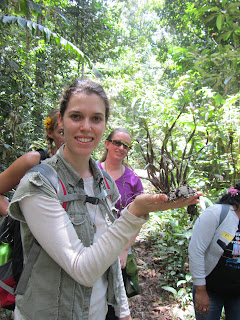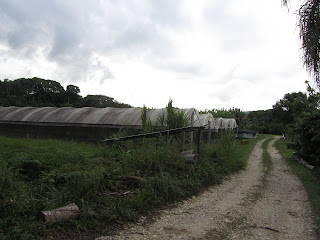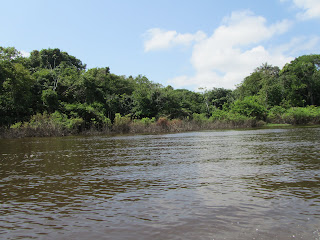Oi, Brasil!

Wednesday, October 3, 2012
Bushwhacking through the Amazonian Jungle
After our tour of the farm, we headed to a primary school for the Wapixana and Macuxi tribes in Pacaraima. Upon arrival, we presented the children with gifts ranging from potato chips to fruit to balloons. We avoided sweets and candies because of the lack of dentistry in the area, but the children were very pleased with their gifts! After, the children treated us by performing their national anthem and two other songs.
After the children's performance, we headed into the jungle for our hike. After checking our blood pressure and pulse to ensure we were all physically fit for the hike, we began our tour of the Amazon jungle.
Throughout the tour, our guide pointed out a number of neat aspects of the jungle. He explained to us the medicinal uses of many of the plants, including cures for malaria, rashes, nausea, and cleansing rituals. We then came across rocks with indigenous cravings dating back hundreds of years, and also found wild orchids and million year old species of fern trees along the path. He also showed us a tree that holds water (similar to a cactus), and cut off a branch, so we could all take a drink!
After, we reached the summit of the hill, where the community is considering adding a bird watching tower for ecotourism. We unfortunately did not see many birds because of the time of day (early morning is best), so we head back down, circling around the hill, and arrived at the Sama River. The river was beautiful and featured the ideal picture of the Amazon jungle. Audriana, Tim and Alex braved the river and went swimming. It was so hot and humid, the water looked tempting, but I knew if I went swimming, my clothes would never dry in the humidity! I'm glad I choose not to go swimming, for that evening Alex found a tick on his side! Gross!
After our break at the river, we headed back to the school. Avoiding a cobra in the path, we began our descent down the hill, in which our tour guides literally had to bushwhack our way through the jungle with machetes. The jungle was so alive that the path would begin to close if you didn’t stay close enough to the person in front of you! Altogether, our hike through the jungle, a total of 6.5 km, was a blast and an experience of a lifetime!
Thursday, September 27, 2012
Tour of the Trigenros Farm
The next day we said our farewells to Manaus, flew north to Boa Vista, and then drove further north to a village called Pacaraima, near the Venezuelan border. After a good night of much needed sleep, we headed out to visit the Trigenros Farm. The Trigenros (Three Generations) Farm in an organic farm nestled in a large valley in the Amazon forest. The farm is laid out to resourcefully use the natural slope of the land for irrigation and to use the tree canopies of the forest as natural shade for the same effect as a cold-frame in order to protect heat sensitive crops. The involvement of the community and the deep understanding of the natural landscape have allowed this farm to thrive on a sustainable agricultural model that is inspiring. Sustainable and organic agriculture is deeply ingrained in the Amazonian culture, and creates harmony and balance between the earth and the people.
The focus of the farm's crop yield balances the demand of the community while nurturing what the land naturally provides. For example, the orchards consists of mandarin, lime, and acai trees which naturally grow in the region. Importing crops that do not naturally originate from the region can cause potential issues with the soil composition by depleting the soil's nutrients. Contrary to my first impression of the land which appears so lush and nutritious, the farmers battle fertility issues with the soil. Only the topsoil, approximately the first 12"-18" of the soil below the surface, is fertile. Thus, the farmers focus their efforts on nurturing the native and indigenous crops produced in this region.
The farm utilizes a number of clever techniques in order to create a sustainable and organic farm in the heart of the Amazon forest. First, the farmers add viscera from animals to the compost to reduce the acidity of the soil and increase the soil's fertility and composition. In addition, crops are rotated regularly to maintain soil composition and integrity. In the cold-frames, it only take 21 days for germination and 45 days for cultivation of crops. And due to the mild climate so close to the equator, crop yields are not seasonal, but can be produced year round. Another neat factoid is that the farmers add sawdust to the animal feed in order to attract the cows into the corral for milking. Apparently cows enjoy the smell of sawdust, and the minimal amount added to the feed does not have health consequences. Plus, with the obedient cows hanging around the corral, the people from the village can come and milk the cows as they please.
Overall, I was inspired by how the farm and the community were in harmony with the earth and with each other. Just seeing how the community and culture thrived from the sustainable and organic agriculture model gave me hope, for this farm would never even consider adding GMO's and unnatural pesticides.
Thursday, September 20, 2012
The Conference
The same afternoon of the boat tour, we attend the SUDI 2012 Conference on Sustainability and Disability hosted by Dr. Gouvea. Dr. Montoya was the last presenter on the subject of "Global Economics, Cultural Entrepreneurship, and Post-Colonialism: Sustainability, Vulnerability, and Disability in the New World Economy." After a long day of presentations and translations (most of the presentations were in Portuguese, but with the sole work of one diligent and hardworking translator, we were able to hear the presentations in English), Dr. Montoya concluded the first day of the conference. Dr. Montoya explored the relationship between the role of colonization to the role of emerging economies today who are fueling most of the world's growth. He then concluded with the theme of 'disability' in the post-colonial theory to economics. Colonialism creates an environment in which individuals and groups are made to feel excluded and not important to the population at large, known as "Alterity" or othering. This perspective of "us vs. them" is being recreated in today's global economy as emerging nations address this concept of vulnerability. This role of disability and vulnerability is best summarized by Dr. Montoya himself: “Disability, is the colonization of the body by the conventions of embodiment, an attitude that assumes that the world has to work a certain way, and that bodies – individual or communal – must all function according to one socio-cultural code or value.” A great conclusion to the first day of the conference!
Thursday, September 13, 2012
Meeting of the Waters
The following morning, we set out on a boat tour of the 'meeting of the water,' where the Rio Negro from the north, flowing down from Venezuela and Colombia, joins the Amazon river right off of the port of Manaus. Our tour guide, Tiago, met us at our hotel and walked us to the port. We then filed into a small motor boat and head out on the water. The day was absolutely beautiful and sunny with a crystal clear sky and a fresh water breeze.
We continued downstream, pasting the expansive and humming industrial port, employing approximately two-thirds of the residents in Manaus. As the city faded in the distance, the forests and jungle thickened alongside the river. Near the shoreline, Igapos (or flooded forests) house anacondas and a plethora of Amazonian wildlife. We then arrived at the junction of the two rivers, where the Rio Negro joins with the Amazon River. The 'meeting of the waters' is famous for the black murky waters of the Rio Negro swirl together with the orange-hued waters of the Amazon, creating a distinctive contrast of where the two rivers flow. The swirling of the two rivers is visible for miles downstream, as the waters from the two rivers remain unmixed. This phenomenon is due to the differences in temperature, speed and water density of the two rivers. Audriana was the only one of us who braved swimming at the 'meeting of the waters,' but she wasn't the only one. Pink, and I mean flamingo pink, dolphins jumped between the two rivers. It was a very beautiful sight!
Alongside the river, there are floating communities, with floating houses, churches and schools. The buildings are floating on huge tree logs and are tethered by rope and steel to the riverbanks. The ropes are adjusted to compensate for the rise and fall of the river during the wet and dry seasons. Electricity now flows to these communities thanks to the previous president of Brazil, Lula da Silva. To address the low college graduation rate from rural communities, Lula installed electricity into remote and isolated communities to help with schooling and so forth. As a result, the graduation rate jumped from 1% to 21%.
On one of the floating houses, we were able to visit with some native Amazonians: sloths and an anaconda! The sloths were so incredibly adorable and cuddly. The snake, however, was just plain creepy! Even though it was only a baby anaconda, it was still scary. Unlike the rest of the group, I didn't hold it. But I did get to hold one of the sloths! So cute!
To conclude our boat trip, we took a little tour through the jungle to the alligator's habitat. Unfortunately, we didn't get to see any alligators, but we saw monkeys, lizards, giant lily pads, and a variety of birds. After, we had a fabulous lunch at a great buffet on the water. The food was delicious and the mangos and bananas were out of this world! It was a wonderful way to end a fabulous boat tour!
The tour of the 'meeting of the waters' was a great experience and illustrated the importance of the Amazon to the people, the culture, the wildlife and the overall ecosystem. I will always treasure this tour!
Subscribe to:
Posts (Atom)





























































